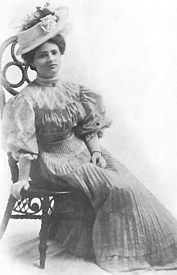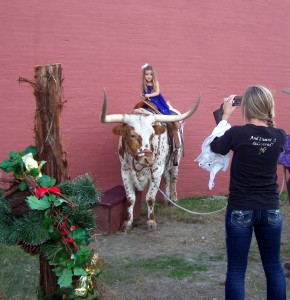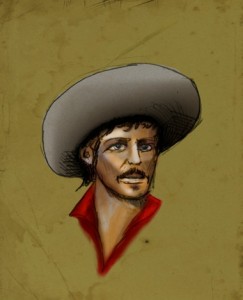There is a Lady, sweet and kind
Was ne’er a face so pleased my mind;
I did but see her passing by…
Thomas Ford 1580-1648
 Her name was Lottie, probably short for Carlotta, and she was a lady. She was usually described as a gorgeous red-head, who arrived in the wild frontier ‘ville that had formed around the military outpost of Fort Griffin, west of Fort Worth, in the years after the Civil War. She was intent on making a fortune for herself … but not in the way that bold, pretty, enterprising and unescorted women usually intended to earn it on arrival in a wide-open frontier town. Or anywhere in the barely-tamed far West, come to think on it. She was not an investor in some chancy enterprise, a mail-order bride or an enterprising whore or brothel madam. She stopped clocks and hearts … but never a poker game.
Her name was Lottie, probably short for Carlotta, and she was a lady. She was usually described as a gorgeous red-head, who arrived in the wild frontier ‘ville that had formed around the military outpost of Fort Griffin, west of Fort Worth, in the years after the Civil War. She was intent on making a fortune for herself … but not in the way that bold, pretty, enterprising and unescorted women usually intended to earn it on arrival in a wide-open frontier town. Or anywhere in the barely-tamed far West, come to think on it. She was not an investor in some chancy enterprise, a mail-order bride or an enterprising whore or brothel madam. She stopped clocks and hearts … but never a poker game.
That was Lottie Deno’s profession – and supposedly, she was good at it; very, very good, with ice-water in her veins instead of blood. One legend has it that one night in the saloon in which Lottie was at the poker-table (likely skinning a green-horn, an unwary cowboy, soldier or drummer of all the coin and valuable property on him) when a sudden exchange of lead civility broke out, and everyone not immediately involved hit the deck. When they rose up from the floor, it was to see Lottie, calm and perfect to every curl of red hair and ruffle on her elaborate dress, saying, “Gentlemen, I came to play poker, not roll around on the floor.” She came by the alias she was best known by after an evening of marathon poker matches in which she had won every hand, when an appreciative and well-likkered-up onlooker with a command of Spanglish whooped, “With winnings like that, you otta call yourself Lotta Dinero!”
She was the older of two daughters of an imperishably respectable and formerly well-to-do Kentucky family named Thompkins, educated in an Episcopalian-run academy for young ladies. Her father had business interests in farming tobacco and hemp … and breeding and racing fine thoroughbred horses at his plantation at Warsaw on the Ohio River. Mr. Thompkins traveled widely – to New Orleans, mostly but also north, to Detroit and apparently to Europe at least once. He reveled in those pleasures of life available to a man of wealth – including gambling, at which he was immensely skilled – or lucky. And for some reason – perhaps because he had some inkling that the future was uncertain and that his daughter might just need a useful skill or two – he taught Lottie to play cards, and to play them very well. Or it just may have been that it amused him to have an able opponent on those evenings at home, before television and the internet.
When the Civil War broke out, Lottie was 17. Kentucky, a border state with strong ties to both North and South remained in the Union. But within a short time, her father had volunteered for service in the Confederate Army and fallen in battle. The fortunes of the family declined precipitously, along with the health of Lottie’s mother. Neither Lottie, her mother, or her younger sister seemed equal to the task of running their property or the late Mr. Thompkin’s business interests, especially not in the middle of a war. The solution as the Thompkins relations and advisors saw it was that Lottie should marry a rich and able man to take on that responsibility – and she was dispatched to Detroit, three hundred miles north of Warsaw, accompanied by her maid and former nanny – a tall and formidable black slave named Mary Poindexter – to achieve that end. Perhaps Lottie was not very keen on the idea to start with, perhaps she ran out of money, or maybe the man who she did strike up an amiable friendship with in Detroit – a man named Johnny Golden, who had ridden her fathers’ horses as a jockey – was unacceptable to her remaining family. Johnny Golden was also a gambler – and within a very short time, Lottie and Johnny, with Mary Poindexter as an attentive chaperone, duenna-and-body-guard combined – were working the professional gambling circuit. Another legend has it that a brash young Union soldier accused Lottie of having cheated him in a game on a riverboat. He started for Lottie, but Mary Poindexter stepped in, and launched the soldier overboard into the river.
Before the war ended, Johnny and Lottie had split up … and Lottie, with the ever-vigilant Mary in attendance … went west. Some say she told her mother and sister back in Kentucky that she had married a wealthy cattleman. Lottie and Mary arrived in San Antonio in 1865, and Lottie took up a job as a dealer in an establishment called the University Club. She was immediately popular, even though the permitted no drinking or cursing at the poker table over which she presided – and Mary Poindexter sat on a stool at her back, just to remind the punters of the respect due to her mistress, who was always elegantly dressed, cultured and the very soul of Southern belle-hood. Very soon she was known as the Angel of San Antonio. The University Club was owned by a man named Frank Thermond; soon, he and Lottie were in love, and Mary Poindexter had soon decided to go her own way. When Frank got into a fight with another gambler and killed him with his Bowie knife, he had to leave town fast. He wound up in New Mexico, while Lottie worked as a professional gambler in various raw settlements in West Texas, where she earned her reputation as the queen of the paste-board flippers.
The end of the story? Not quite what you’d expect. By 1882, she and Frank Thermond were reunited – and married – and living quiet respectable lives in Deming, New Mexico. He went into business – real estate, mostly – and was vice-president of the local bank. Lottie also was an upright pillar of the community, helping to establish an Episcopal church in Deming. She died in 1934, outliving her husband by 26 years, but not a certain legend. It is commonly said that she was the model for the character of Miss Kitty, in the old Gunsmoke radio and television series.



Recent Comments